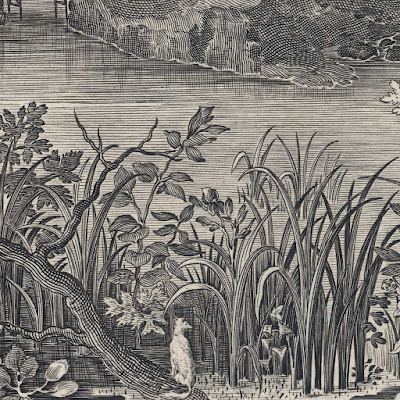Jan van Londerseel (aka Johannes
van Londerseel) (1578–c1625) (according to the BM or an anonymous printmaker
according to the Rijksmuseum)
“Judah and Tamar”, 1590–1625, after a print by Nicolaas de Bruyn (aka Nicolaas de Bruin;
Nicolaes de Bruyn) (1571–1656), after the design by Maarten de Vos (aka Marten de Vos; Maerten de Vos) (1532–1603), after Gillis
van Coninxloo (aka Egidius Coninxlogensis; Gillis van Coningsloo) (1544–1607),
plate 23 from the series of 131 engraved illustrations (including the title
page) to the “Royal-Size Bible” (aka Historiae Sacrae Veteris et Novi
Testamenti; Biblische figuren, Darinen die fürnembste historien, in heiliger
Schrifft begriffen, geschichtmässig entworffen; Figures de la Bible,
demonstrans les principales histoires de la Saincte Escriture; Bybelsche
figuren, vertonende de voornaemste historien der Heylige Schrifture; Figures of
the Bible, in wich almost every history of the Holy Scriptures is described),
published by Nicolaes Visscher I (aka Nicolaas Visscher; Claes Claesz
Visscher) (1618–1679) and Claes Jansz. Visscher (aka Piscator; Nicolaes
Jansz Visscher) (1587–1652) in Amsterdam.
Engraving on laid paper with red ink
lines marking upper and lower borders and a centerfold (as published), trimmed
near the image borderline and backed with a support sheet.
Size: (sheet) 39 x 52.5 cm; (image
borderline) 36.6 x 52.3 cm
Inscribed on plate within the image
borderline: (lower left) "Egidius Coningsloo inven. CIViβcher Excu."
Lettered in Latin text on plate below
the image borderline: "IUDAS ET
THAMAR COEUNT PROMITTITUR HOEDUS
ANNULUS, ARMILLÆ, ATQUE PEDUM PRO PIGNORE DANTUR. Genesis 38.6."
Hollstein 10 (Londerseel); Hollstein 21
(after Gilles van Coninxloo); Hollstein undescribed (Visscher)
The British Museum offers the following
description of this print:
“Judah and Tamar [Genesis 38:6]; woody
landscape with an elderly man embracing a younger woman in lower left, the
woman holding a ring and looking at it, a castle surrounded by a moat at
centre, mountains and a cascading river in background; after Gillis van
Coninxloo; from a series of 130 engravings (plus title-page) forming a Picture
Bible”
See also the description of this print
at the Rijksmuseum:
Condition: a near faultless early
impression (based on the crisp lines and lack of wear to the plate), richly
inked and well-printed, trimmed close to the image borderline and backed with a support sheet of
archival (millennium quality) washi paper. There are ruled red ink lines
bordering the image at the top and lower edges. Otherwise the sheet is in near
pristine condition (i.e. there are no tears, holes, folds—apart from the
flattened centrefold of publication—abrasions, stains, foxing or signs of
use).
I am selling this huge engraving showing
not only the shocking liaison between a father-in-law and his daughter-in-law who he
has mistaken for a whore, but also a sublime landscape designed by the
brother-in-law of Pieter Brueghel the Younger, for AU$405 in total (currently
US$299.05/EUR259.01/GBP231.37 at the time of posting this listing) including
postage and handling to anywhere in the world (but not, of course, any import
duties/taxes imposed by some countries).
If you are interested in purchasing this
masterpiece from the late 1500s/early 1600s, please contact me
(oz_jim@printsandprinciples.com) and I will send you a PayPal invoice to make
the payment easy.
This print has been sold
I have previously listed an illustration of the story for Judah and Tamar executed by Harmen Jansz. Muller, but for
those who may have missed the account of what is portrayed in this scene I will
give a VERY brief explanation: the chap in the foreground is Tamar and he has
mistaken his daughter-in-law, Judah, for a prostitute. He is shown here engaged
in the act of purchasing her services by offering her his signet ring which she
examining along with his staff which she holds. These items along with
bracelets (which the artist has failed to portray) are collateral for a goat which
she is later to receive as advised in the Latin text beneath the image: (transl.)
“… rings, bracelets, and crook given as collateral. Genesis 38.6”
The publication of this engraving in the
“Royal-Size Bible” is rather complicated and so I will leave the explanation to
the account offered by the British Museum:
“… a series of 130 engravings known as
the 'Royal-Size Bible'. It contains 65 biblical scenes from the Old Testament
and 65 biblical scenes from the New Testament; the project was originally
started by Claes Jansz Visscher and published by his son Nicolaes after his
father's death in 1652. Some prints have the address of Claes Jansz Visscher
and others have the address of Nicolaes Visscher, meaning the elder Visscher
might have published some plates separately before. The prints are printed on
royal size paper (roughly 400 mm by 500 mm), folded vertically and inserted on
tabs, bound together in a blindstamped vellum cover. The prints are made by and
after various artists. Most of the prints were taken from earlier print series
and selected by Visscher to make up a new set and create this Picture Bible,
others seem specially made for Visschers' Picture Bible by an unidentified
printmaker. Some of the plates were engraved by Pieter Nolpe and Johannes van
Londerseel. Many compositions from the 'Theatrum Biblicum' (another Picture
Bible published by Claes Jansz Visscher) were copied, transferred to the royal
format, as were inventions of artists such as David Vinckboons, Maerten de Vos,
Gillis van Coninxloo, Melchior d'Hondecoeter, Peter Paul Rubens, Abraham van
Diepenbeeck and Nicolaas de Bruyn.”
The Rijksmuseum also gives an account of
the publication details:









No comments:
Post a Comment
Please let me know your thoughts, advice about inaccuracies (including typos) and additional information that you would like to add to any post.